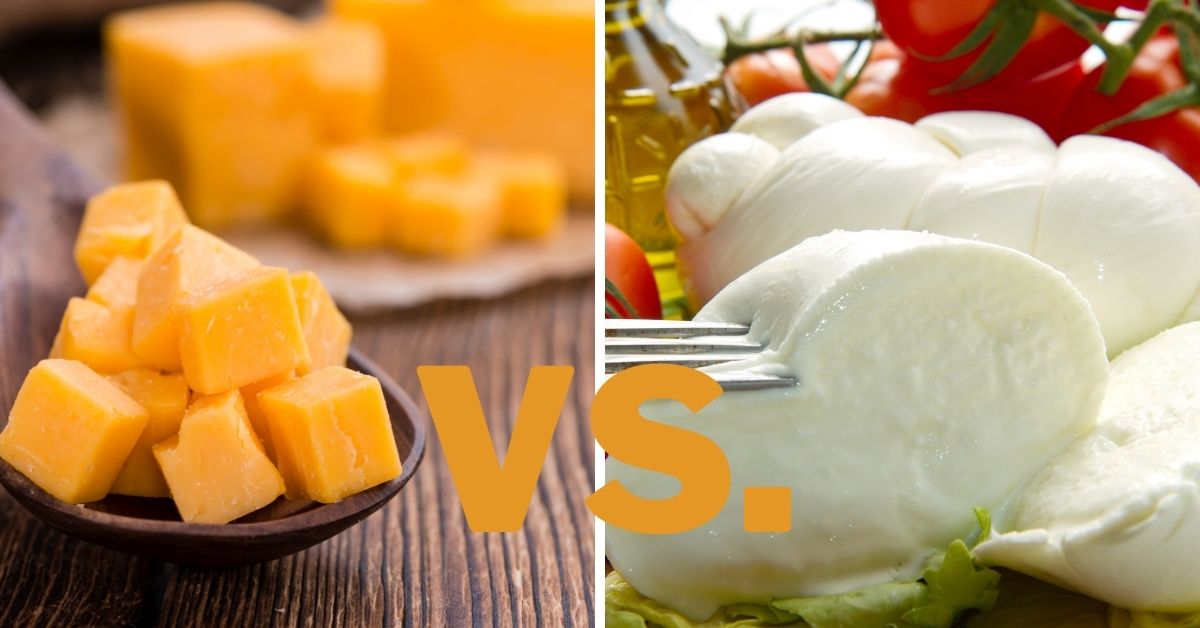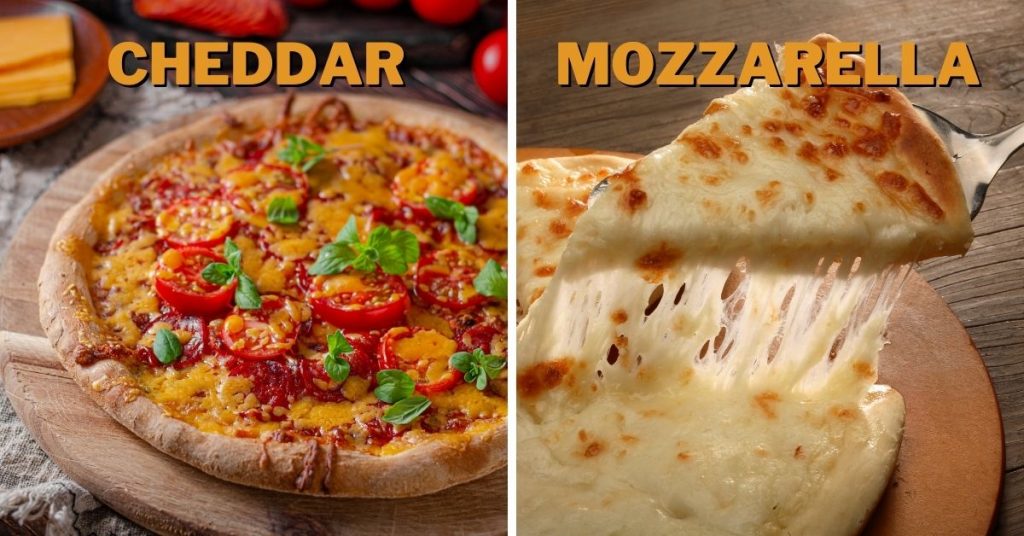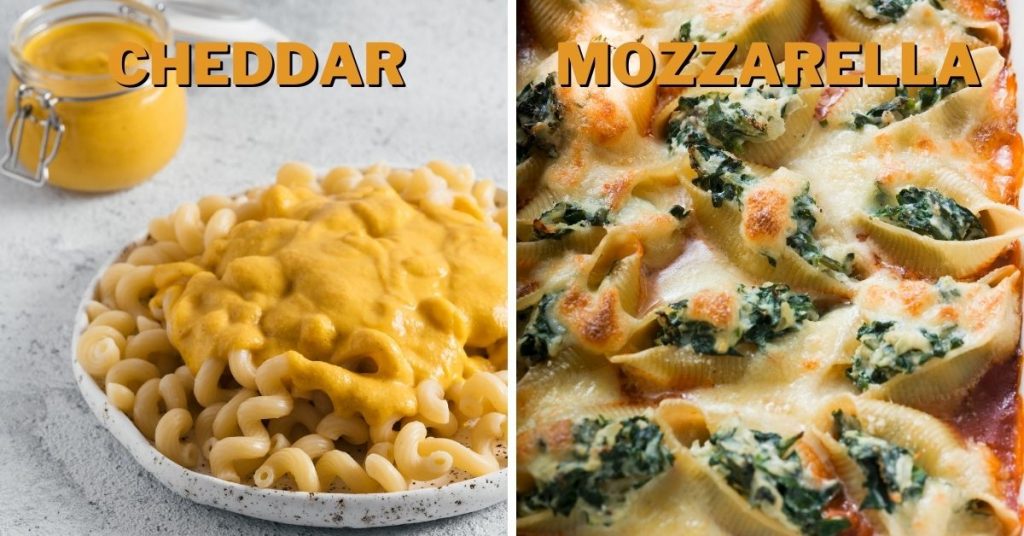Cheddar vs. Mozzarella: Differences, Uses & Which Might You Like More

Cheddar and Mozzarella are both famous cheeses and are widely used worldwide. These two kinds of cheese are made from milk, but because their making processes are different, they taste and act differently in foods. So, what are the differences between Cheddar and Mozzarella?
Differences between Cheddar and Mozzarella
Taste
Cheddar cheese is famous for its unique and sharp taste. People use it in dishes for an extra flavor, which gives the food another taste level. This classic cheese has a sharp and intense flavor and is considered to be slightly earthy because it takes 3 to 6 months to process.
An enzyme called peptide caused the bitter sharpness in Cheddar. The more aged the cheese becomes, the more bitterness it gains.
On the other hand, Mozzarella cheese is not famous for its flavor. Mozzarella cheese is more famous for its iconic cheese pull function. Mozzarella cheese is bland in taste, and when it’s melted, it forms an elastic texture that Mozzarella lovers desire. The subtle taste of Mozzarella cheese is slightly sour and salty with freshness like milk.
Despite having different flavors and tastes, Mozzarella cheese becomes sour and gains more flavor with time, like Cheddar.

Melting
Unlike other cheeses, Mozzarella from brine doesn’t melt easily. But, when it melts, it creates a gooey texture. When you see a TV commercial for some pizza place and see cheese making the long strings, there is a high possibility that that’s Mozzarella. Even the process of making Mozzarella is called string dough.
Thanks to its elasticity, Mozzarella is a favorite cheese for pizza, pasta dishes, fried Mozzarella sticks and Panini.
Shredded Cheddar cheese is used in many dishes for its unique and sharp taste. It gives any food an extra flavor boost and melts right away when heated. Usually, Cheddar cheese takes a few months to gain its classic bitterness flavor.
Compared to aged and young Cheddar cheese, the young Cheddar is for you if you want melty cheese. The aged Cheddar has less moisture and that is why it does not melt like the young one.

Nutrition
As Mozzarella and Cheddar cheese are both derived from cow milk (Mozzarella is also made from water buffalo), they share similar nutritional values.
Mozzarella is lower in sodium and calories than most other cheeses, but it is enriched with bacteria that act as probiotics. Probiotics can improve your hurt health, increase immunity, and fight against inflammation in your body. [1]
Cheddar cheese has slightly more calories and sodium than Mozzarella. It is a good source of vitamin K2 which is important for heart and bone health.
Smell
Mozzarella cheese is made and served fresh, which means it takes less time to make and is consumed quickly. That is why Mozzarella cheese has no strong odor like other cheeses. It has a light and mild aroma, like fresh milk. It tastes as good as it smells.
However, due to the making process and time, Cheddar cheese smells completely different than Mozzarella. It has a strong bitter odor, and some say it has an earthy smell. This is only because Cheddar needs time to regain its original taste.
After the making process, the Cheddar is kept in the cellar for a few months. The more the Cheddar is aged, the more strong odor it gains.
Uses
As I said earlier, Cheddar cheese is mainly used by cheese lovers to boost the taste of food. Like other cheeses, Cheddar has several uses. It is mostly used in cheese sandwiches and burgers.
People who love the strong flavor of Cheddar use it in macaroni and cheese, different soups and on a cheese plate with dry peaches.
Mozzarella cheese is known as an allrounder cheese for its versatile usage. It can go with most of the dishes like pizza, pasta, macaroni, lasagna, pizza quesadillas, or casserole, meatball, etc. If you want a cheese pull action in your food, Mozzarella is the go-to cheese. For this specialty, you can deep fry it with bread crumb coating and enjoy the mouth-watering cheese fry.
Preparation
Mozzarella cheese is made with either water buffalo or cow’s milk. No matter which type of milk is used, the making process is always the same. It is not aged like others and should be consumed shortly after being prepared. It looks like a white ball and when heated it melts like rubber. This rubber-like cheese-making process is called pasta “filata.”
The making process starts with the milk which is incubated in a large bowl containing whey stater mixed with thermophilic bacteria. To form the curds, rennet is added, and after this step, the curds are heated in the bowl until they become elastic in texture. Finally, when the curds are ready, they are stretched and kneaded to gain a smooth ball-like form.
The first step of making Cheddar cheese is similar to the process of making Mozzarella cheese. First of all, the cow milk is cultured with bacteria to acidify the milk. After that, rennet is added to form curds.
When the curds are formed, the liquid whey is drained out, and curds gain more concentration. Then the concentrated curds are heated up to 100 degrees Fahrenheit to melt together, releasing more watery whey.
In this second step, the Cheddar cheese-making process is exempt from others and it is called the Cheddaring process. Now, the concentrated curds are formed into giant slabs and are flipped repeatedly to release more whey.
After that, the slabs are run through a mill to cut into small pieces and pressed into molds to drain the remaining whey. Finally, these round-shaped curds are kept in a cellar for 3 to 6 months to form the classic Cheddar cheese.
Texture
Fresh Mozzarella cheese looks and feels like a soft white ball with a rubbery texture. When it is melted in the heat, it acts as an elastic substance. In contrast, Cheddar cheese is slightly yellowish, hard, and fragile in texture. When. When young Cheddar cheese is heated, it melts right away.
Origin
Mozzarella cheese is made from Italian Mediterranean buffalo, and it is being made traditionally in Italy. Nowadays, it is made in several countries and even made with cow milk.
On the other hand, Cheddar cheese originated in the town of Cheddar Gorge, England. It is made from cow milk. Although it is originally from England, it is produced in several countries such as the United States, Canada, Netherland, New Zealand, and Australia, among many other countries.
Cheddar or Mozzarella: Which might you like more?
It depends on personal taste buds and preferences. If you want cheese pull action from your food without adding sharp flavor, you can go with Mozzarella. If you want the sharp flavor of the cheese in your food, then Cheddar is the right option.
Do Cheddar and Mozzarella go together?
Cheddar and Mozzarella go perfectly together. To make the best pizza, it should look golden, have a bursting cheese taste, and have the perfect amount of elasticity. So, the right amount of Cheddar and Mozzarella cheese mixed with dishes can have flavor and elasticity.
Cheddar or Mozzarella: Which is better for pizza?
Mozzarella cheese has a subtle flavor and a rubbery texture when melted on pizza, so it is used most of the time. On the other hand, Cheddar cheese has a sharp and bitter taste, so it is used in pizza in small amounts.

Cheddar vs. Mozzarella: Which is better for pasta?
Both Cheddar and Mozzarella are great for pasta. Cheddar cheese is better for pasta sauce or macaroni and cheese, while Mozzarella is better if you put it on the pasta and bake it in the oven.

To conclude, both Cheddar and Mozzarella can guarantee a creamy, salty, and rich experience, whether you are putting them on a pizza, pasta, or lasagna. The best part is that you can put both on the same dish to make them taste even better.
